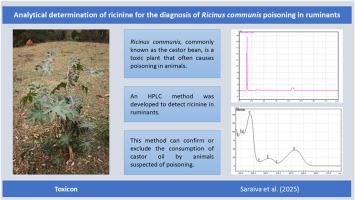反刍动物蓖麻中毒诊断中蓖麻碱的分析测定
IF 2.4
4区 医学
Q2 PHARMACOLOGY & PHARMACY
引用次数: 0
摘要
蓖麻,俗称蓖麻豆,是一种经常引起动物中毒的有毒植物。本研究旨在建立并验证一种高效液相色谱(HPLC)紫外检测法测定尿液、肝脏和牛瘤胃液样品中蓖麻碱水平的分析方法,作为诊断蓖麻中毒的化学标志物。结果表明,蓖麻碱的检出限和定量限随波长的不同而变化,在208 nm时较低,其次是308 nm和315 nm。肝脏样品的检出限分别为0.375 μg/g(波长218 nm)和1.25 μg/g (315 nm),检出限分别为1.25 μg/g (218 nm)和4.175 μg/g (315 nm)。瘤胃液和尿液的检出限分别为0.15 μg/mL (218 nm)和0.5 μg/mL (315 nm),检出限分别为0.5 μg/mL (218 nm)和1.67 μg/mL (315 nm)。因此,可以使用本研究提出的提取方法检测蓖麻碱以确认蓖麻暴露,然后通过HPLC和UV-Vis检测肝脏、尿液和瘤胃液样品进行分析。本文章由计算机程序翻译,如有差异,请以英文原文为准。

Analytical determination of ricinine for the diagnosis of Ricinus communis poisoning in ruminants
Ricinus communis, commonly known as the castor bean, is a toxic plant that often causes poisoning in animals. The present study aims to develop and validate an analytical method for determining ricinine levels in urine, liver, and bovine ruminal fluid samples for use as a chemical marker in diagnosing poisoning by R. communis using high-performance liquid chromatography (HPLC) with ultraviolet detection. The method developed in this study showed that the limit of detection (LOD) and limit of quantification (LOQ) of ricinine varied according to the wavelength used, being lower when using 208 nm, followed by 308 nm and 315 nm. In liver samples, the LOD was 0.375 μg/g (using a wavelength of 218 nm) and 1.25 μg/g (315 nm), and the LOQ was 1.25 μg/g (218 nm) and 4.175 μg/g (315 nm). For rumen fluid and urine samples, the LOD was 0.15 μg/mL (218 nm) and 0.5 μg/mL (315 nm), respectively, and the LOQ was 0.5 μg/mL (218 nm) and 1.67 μg/mL (315 nm), respectively. Thus, the detection of ricinine to confirm the exposure to castor beans can be achieved using the extraction method presented in this work, followed by analysis via HPLC and UV–Vis detection of liver, urine, and ruminal fluid samples.
求助全文
通过发布文献求助,成功后即可免费获取论文全文。
去求助
来源期刊

Toxicon
医学-毒理学
CiteScore
4.80
自引率
10.70%
发文量
358
审稿时长
68 days
期刊介绍:
Toxicon has an open access mirror Toxicon: X, sharing the same aims and scope, editorial team, submission system and rigorous peer review. An introductory offer Toxicon: X - full waiver of the Open Access fee.
Toxicon''s "aims and scope" are to publish:
-articles containing the results of original research on problems related to toxins derived from animals, plants and microorganisms
-papers on novel findings related to the chemical, pharmacological, toxicological, and immunological properties of natural toxins
-molecular biological studies of toxins and other genes from poisonous and venomous organisms that advance understanding of the role or function of toxins
-clinical observations on poisoning and envenoming where a new therapeutic principle has been proposed or a decidedly superior clinical result has been obtained.
-material on the use of toxins as tools in studying biological processes and material on subjects related to venom and antivenom problems.
-articles on the translational application of toxins, for example as drugs and insecticides
-epidemiological studies on envenoming or poisoning, so long as they highlight a previously unrecognised medical problem or provide insight into the prevention or medical treatment of envenoming or poisoning. Retrospective surveys of hospital records, especially those lacking species identification, will not be considered for publication. Properly designed prospective community-based surveys are strongly encouraged.
-articles describing well-known activities of venoms, such as antibacterial, anticancer, and analgesic activities of arachnid venoms, without any attempt to define the mechanism of action or purify the active component, will not be considered for publication in Toxicon.
-review articles on problems related to toxinology.
To encourage the exchange of ideas, sections of the journal may be devoted to Short Communications, Letters to the Editor and activities of the affiliated societies.
 求助内容:
求助内容: 应助结果提醒方式:
应助结果提醒方式:


